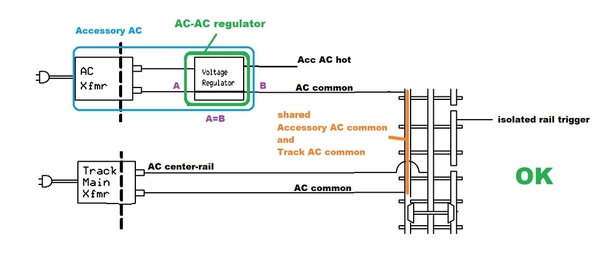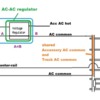Agreed. Tracing currents between power systems is tedious at best. But based on your comments I think I've stumbled on the root-cause of the confusion.
Since day 1 O-gaugers have used the isolated rail trigger method to activate accessories and what not. In other words, the idea of sharing commons is NOT the issue. For example, as shown above, you might have a separate Accessory AC transformer to power turnouts, uncoupling tracks, and so on. The commons between the Accessory AC and Track AC power sources are shared which makes insulated-rail triggering possible.
Even layouts that don't use insulated-rail triggering routinely share the outer rail for, say, block-power configurations where there may be a handful of train transformers. As an aside, for anyone following along, the often discussed issue of "phasing" multiple AC transformers in a multi-block system is related in that when a train straddles two blocks it is adding the "dreaded" 2nd connection thereby creating a to-and-from "circuit" which is bad. Phasing is a technique to demote the effect of this undesired new circuit.
Thus, shared commons are routine and not the issue. Instead, I believe the confusion stems from how AC voltages are converted to DC voltages. That is, we have been conditioned to expect the SAME AC common when regulating or adjusting AC voltages to another AC voltage in a train transformer. For the most part, AC-to-AC circuits in modern train transformers use the semiconductor triac to chop the AC waveform to lower the voltage. This method preserves the common between the input side and output side.
On the other hand, when converting from AC-to-DC, the bridge rectifier rears its ugly head by breaking the sacred bond between the input common and the output common. In other words, there is no longer a "common" common! Terminology such as "return" or "ground" or "minus side" etc. are frequently used in an attempt to distinguish this. But I think the average user has become so accustomed to the idea of a universal common (that resides on the outer rail) that it's hard to put one's arms around the idea of multiple commons.
-----
So leaving the world of shared commons, your question about other diode examples. I have a good one! Lots of guys have been converting rolling stock lighting from bulbs to LEDs. In many cases they are using bridge-rectifiers to convert track-AC to DC as needed by LEDs. But this breaks that sacred bond between AC input common (the outer rail) and output common (DC- to the LEDs). The practical gotcha is you can no longer use the frame or chassis of the rolling stock as the DC common. I seem to recall several threads where this was the burning (literally) issue! As with my example for the station-stop, you can preserve the AC and DC common by using a single diode (half-wave rectification) instead of a 4-diode bridge rectifier.






